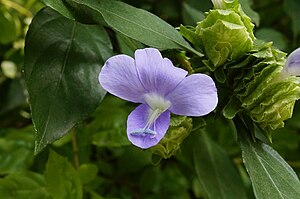Note: This is a project under development. The articles on this wiki are just being initiated and broadly incomplete. You can Help creating new pages.
Barleria strigosa - Nīlajhiṇṭī
(Redirected from Barleria strigosa Willd - Nīlajhiṇṭī)
Nīlajhiṇṭī consists of root of Barleria strigosa. It is a tall herb which is distributed throughout the upper gangentic plain and southern parts of India.
Contents
- 1 Uses
- 2 Parts Used
- 3 Chemical Composition
- 4 Common names
- 5 Properties
- 6 Habit
- 7 Identification
- 8 List of Ayurvedic medicine in which the herb is used
- 9 Where to get the saplings
- 10 Mode of Propagation
- 11 How to plant/cultivate
- 12 Season to grow
- 13 Required Ecosystem/Climate
- 14 Kind of soil needed
- 15 Commonly seen growing in areas
- 16 Photo Gallery
- 17 References
- 18 External Links
Uses
Serious catarrhal infections, Boils, Snake bites, Sores.
Parts Used
Chemical Composition
The plant gave beta-and gammasitosterol. [1]
Common names
| Language | Common name |
|---|---|
| Kannada | |
| Hindi | |
| Malayalam | |
| Tamil | |
| Telugu | |
| Marathi | NA |
| Gujarathi | NA |
| Punjabi | NA |
| Kashmiri | NA |
| Sanskrit | |
| English |
Properties
Reference: Dravya - Substance, Rasa - Taste, Guna - Qualities, Veerya - Potency, Vipaka - Post-digesion effect, Karma - Pharmacological activity, Prabhava - Therepeutics.
Dravya
Rasa
Guna
Veerya
Vipaka
Karma
Prabhava
Habit
Identification
Leaf
| Kind | Shape | Feature |
|---|---|---|
| Simple | Opposite | Petiole brownish yellowish strigose and 0.7–2.5cm. |
Flower
| Type | Size | Color and composition | Stamen | More information |
|---|---|---|---|---|
| Bisexual | Terminal spikes | Pink-violet | Flowers in terminal dense spikes and in axillary to 5 cm. |
Fruit
| Type | Size | Mass | Appearance | Seeds | More information |
|---|---|---|---|---|---|
| Capsule | 1.4–1.8 x ca. 0.5 cm | Capsule is ellipsoid, glabrous, 1.4–1.8 x ca. 0.5 cm, shining, four-seeded. |
Other features
List of Ayurvedic medicine in which the herb is used
Where to get the saplings
Mode of Propagation
How to plant/cultivate
Season to grow
Required Ecosystem/Climate
Kind of soil needed
Well drained soil[6]
Commonly seen growing in areas
[[:Category:Herbs that are commonly seen in the region of |]], [[:Category:Herbs that are commonly seen in the region of |]].
Photo Gallery
References
- ↑ Chemical composition
- ↑ Morphology
- ↑ [Cultivation detail]
- ↑ Cite error: Invalid
<ref>tag; no text was provided for refs namedSeason to grow - ↑ Cite error: Invalid
<ref>tag; no text was provided for refs namedRequired Ecosystem/Climate - ↑ Kind of soil needed
External Links
Categories:
- Pages with reference errors
- Ayurvedic Herbs known to be helpful to treat Serious catarrhal infections
- Ayurvedic Herbs known to be helpful to treat Boils
- Ayurvedic Herbs known to be helpful to treat Snake bites
- Ayurvedic Herbs known to be helpful to treat Sores
- Herbs with Flower used in medicine
- Habit - Evergreen shrub
- Index of Plants which can be propagated by Seeds
- Herbs that are commonly seen in the region of
- Herbs
- Acanthaceae



